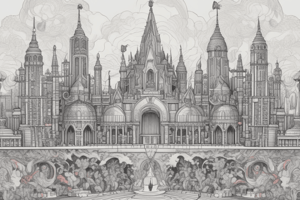Podcast
Questions and Answers
The genre that utilizes a 4 drum 4 routine is called ______.
The genre that utilizes a 4 drum 4 routine is called ______.
break beat
The style of dance music known for its huge bass line is ______.
The style of dance music known for its huge bass line is ______.
drum and bass
The music known for high volume vocals and rhythmic instrumentation is referred to as ______.
The music known for high volume vocals and rhythmic instrumentation is referred to as ______.
disco
The musical genre that began in Great Britain and features percussive rhythms and kicks is known as ______.
The musical genre that began in Great Britain and features percussive rhythms and kicks is known as ______.
The electronic music style that has no traditional verse and is structured with a formation, climax, and end is called ______.
The electronic music style that has no traditional verse and is structured with a formation, climax, and end is called ______.
Which type of music is characterized by an intense style and a combination of various musical genes?
Which type of music is characterized by an intense style and a combination of various musical genes?
What is a defining characteristic of trance music?
What is a defining characteristic of trance music?
What distinguishes eurodance music from other electronic genres?
What distinguishes eurodance music from other electronic genres?
Which musical genre is categorized as having a mixture of disco and soul music?
Which musical genre is categorized as having a mixture of disco and soul music?
What characterizes down tempo music compared to other genres?
What characterizes down tempo music compared to other genres?
Flashcards are hidden until you start studying
Study Notes
Music Genres and Styles
- Ambient: Composed to evoke imagery, creating atmospheric soundscapes.
- Break Beat: Characterized by a 4/4 drum pattern, essential for rhythmic complexity.
- Drum and Bass: A dance music genre known for its deep bass lines and high energy.
- Industrial: Features an intense and aggressive sound, often blending various musical elements.
- Disco: Recognized for high-volume vocal performances and rhythmic instrumentation that promotes dance.
- Down Tempo Music: Known for its peaceful and relaxing qualities, often employing hypnotic beats.
- Electromusic: Utilizes precise synthesizers to create electronic soundscapes.
- Electronics: Can serve as either foreground music for engagement or background music for ambiance.
- Eurodance Music: A fusion of dance and techno with prominent, heavy vocal tracks.
- Hardcore Music: Lacks tonal focus, offering fast-paced beats and intricate patterns.
- House Music: Combines elements of disco and soul, creating an uplifting and danceable vibe.
- Progressive: A subgenre of house music lacking verses, focusing instead on structure and energetic climax.
- Techno: Emerged in the 1980s as one of the most popular electronic dance music styles.
- Trance: Features repetitive phrases and build-ups, popular in party settings for its euphoric feel.
- UK Garage: Originated in Great Britain, known for its distinctive percussive rhythms and kick patterns.
Musical Instruments and Innovators
- Theremin: An electronic musical instrument invented by Leon Theremin, known for its unique sound.
- Martenot: Developed by Maurice Martenot, this instrument produces an ethereal sound reminiscent of the theremin.
- Telharmonium: Created by Thaddeus Cahill, this early electrical musical instrument laid groundwork for future electronic music.
Music Genres and Styles
- Ambient: Composed to evoke imagery, creating atmospheric soundscapes.
- Break Beat: Characterized by a 4/4 drum pattern, essential for rhythmic complexity.
- Drum and Bass: A dance music genre known for its deep bass lines and high energy.
- Industrial: Features an intense and aggressive sound, often blending various musical elements.
- Disco: Recognized for high-volume vocal performances and rhythmic instrumentation that promotes dance.
- Down Tempo Music: Known for its peaceful and relaxing qualities, often employing hypnotic beats.
- Electromusic: Utilizes precise synthesizers to create electronic soundscapes.
- Electronics: Can serve as either foreground music for engagement or background music for ambiance.
- Eurodance Music: A fusion of dance and techno with prominent, heavy vocal tracks.
- Hardcore Music: Lacks tonal focus, offering fast-paced beats and intricate patterns.
- House Music: Combines elements of disco and soul, creating an uplifting and danceable vibe.
- Progressive: A subgenre of house music lacking verses, focusing instead on structure and energetic climax.
- Techno: Emerged in the 1980s as one of the most popular electronic dance music styles.
- Trance: Features repetitive phrases and build-ups, popular in party settings for its euphoric feel.
- UK Garage: Originated in Great Britain, known for its distinctive percussive rhythms and kick patterns.
Musical Instruments and Innovators
- Theremin: An electronic musical instrument invented by Leon Theremin, known for its unique sound.
- Martenot: Developed by Maurice Martenot, this instrument produces an ethereal sound reminiscent of the theremin.
- Telharmonium: Created by Thaddeus Cahill, this early electrical musical instrument laid groundwork for future electronic music.
Studying That Suits You
Use AI to generate personalized quizzes and flashcards to suit your learning preferences.




